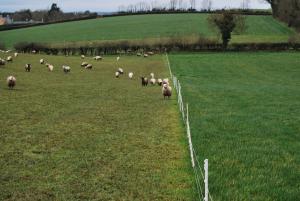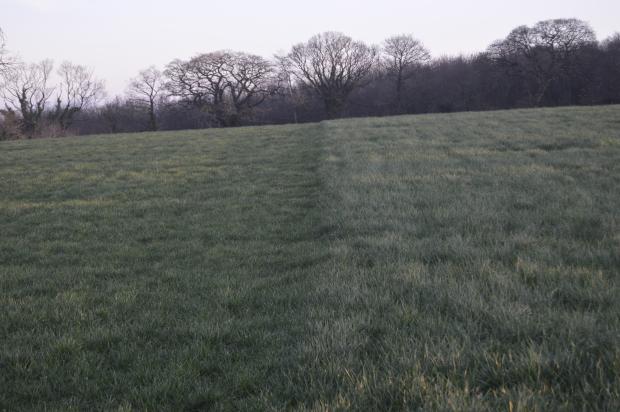To graze or not to graze winter swards – this is the question!
Date published:
The management of grass silage swards during the autumn may impact the quality of silage produced during the following year.

Background
Increasingly milder winters, together with the practice of applying slurry to swards after the final harvest of silage, promote grass growth over the autumn and winter periods. However, if swards accumulate high herbage covers over the winter, some of this material can die-off, and this can reduce the quality and digestibility of first cut silage the following year. In a recent survey of local dairy farmers, 30% of those questioned indicated that they believed this autumn/winter grass growth was having a large or very large negative impact on first cut silage quality. While many farmers try to remove this autumn grass, normally by grazing with sheep, this is not always possible. This study, which was co-funded by DAERA and AgriSearch, examined the impact on silage quality and subsequent cow performance of using sheep to remove this autumn grass.
The study
This study was repeated over two years. Following the harvest of third cut silage in mid-September, a five-hectare block of land was treated with slurry (approximately 3,300 gallons/acre), and managed according to one of two treatments: half of the area was left un-grazed, while the other half was grazed by a group of non-pregnant ewe lambs during December. Ewes were allowed to graze until a target cover of 1,400 kg DM/ha was obtained (post-grazing height of approximately 4 cm). Both areas received slurry and fertiliser in the spring in preparation for first cut silage. The two treatment swards (‘Grazed’ and ‘Un-grazed’) were subsequently harvested and ensiled in separate silos in early May. The silages made from the Grazed and Un-grazed swards were then offered to mid/late-lactation dairy cows. In Year 1 cows were supplemented with 8 kg of concentrates/day, while in Year 2 cows where supplemented with 4 kg of concentrates/day, due to their later stage of lactation and lower milk yields.
Outcomes
Grass yields and silage quality
Allowing sheep to graze the swards during December resulted in a reduction in yield when herbage was harvested the following spring (0.8 and 1.0 t dry matter/ha greater with the Un-grazed swards compared to the Grazed swards in Years 1 and 2, respectively). The smaller yield loss in Year 1 coincided with a milder winter, which allowed grass plants to continue growing, albeit at a much slower rate. A number of frosts in Year 2 likely delayed sward recovery following grazing.
The chemical composition of silages made from Grazed and Un-grazed swards were in general very similar, with the exception of metabolisable energy content (Table 1). In Year 1, the metabolisable energy content of the silage produced from the Grazed sward was 0.2 MJ/kg DM higher than that produced from the Un-grazed swards, while in Year 2, this difference was 0.5 MJ/kg DM higher. This is due in part to the higher percentage of dead plant material which was found in the Un-grazed sward at the time of harvest.
| Year 1 | Year 2 | |||
| Grazed | Un-grazed | Grazed | Un-grazed | |
| Dry matter (%) | 28.7 | 30.5 | 20.5 | 20.8 |
| Metabolisable energy (Mj/kg DM) | 11.1 | 10.9 | 11.8 | 11.3 |
| Crude protein (% DM) | 17.6 | 17.9 | 12.3 | 12.9 |
| pH | 4.1 | 4.1 | 3.7 | 3.7 |
| Ammonia (% total nitrogen) | 6.2 | 6.1 | 5.1 | 6.5 |
| Lactic acid (% DM) | 9.2 | 8.8 | 13.7 | 10.5 |
| Dry matter yield (t/ha) | 6.2 | 7.0 | 6.7 | 7.7 |
Impact on cow performance
In Year 1, silage DM intake was unaffected by autumn sward management practice, likely because the nutritional value of the silages were reasonably similar. However, cows offered silage made from the Grazed sward produced 0.8 kg more milk per day compared to those offered silage produced from the Un-grazed sward, an increase of 3% (Table 2). In Year 1, none of the other production parameters examined differed statistically between treatments. In Year 2, cows offered the silage produced from the Grazed sward consumed 1.5 kg more silage DM compared to those offered silage produced from the Un-grazed sward, a 14% increase in silage DM intake. However, this increase in silage DM intake did not translate into an increase in milk yield. Nevertheless, cows offered silage produced from the Grazed sward tended to produce milk with a higher milk fat content, resulting in a 9% increase in fat plus protein yield. The reasons for the higher milk fat content with this treatment are unclear at present.
| Year 1 | Year 2 | |||||
| Silage from Grazed swards | Silage from Un-grazed swards | % Change | Silage from Grazed swards | Silage from Un-grazed swards | % Change | |
| Silage DM intake (kg/day) | 16.8 | 16.3 | 13.3 | 11.6 | +14% | |
| Total DM intake (kg/day) | 23.6 | 23.1 | 16.7 | 15.2 | +10% | |
| Milk Yield (kg/d) | 27.0 | 26.2 | +3% | 21.4 | 20.8 | |
| Fat content (%) | 4.98 | 5.08 | 5.71 | 5.21 | +10% | |
| Protein content (%) | 3.71 | 3.72 | 3.87 | 3.88 | ||
| Fat plus protein yield (kg/day) | 2.34 | 2.31 | 2.07 | 1.90 | +9% |
Practical Implications
Using sheep to remove grass that grew during the autumn period resulted in swards with less dead plant material, leading to silage with a higher metabolisable energy content, especially in Year 2. This was associated with higher silage intakes, and improved yields of milk solids in Year 2. However, the improved performance per cow needs to be considered within the context of the lower silage yields associated with the grazed swards. For example, when differences in herbage yields are considered within this study, total yields of fat plus protein per hectare were actually 128 kg and 218 kg/hectare higher (Year 1 and 2, respectively) with the Un-grazed swards.

Conclusions
The benefits, or otherwise, of removing autumn growth herbage by grazing sheep will likely be influenced by weather conditions during the winter and spring, and their impact on subsequent sward growth and/or sward ‘die-off’. However, at the time that the decision to graze/not graze has to be made, farmers cannot know what the weather will hold throughout the winter/spring. In general, it is recommended that heavy grass covers should be removed by grazing livestock in late autumn. However, given the impact of sheep grazing on herbage yield the following spring, the date that sheep are removed from swards, and the residual grazing heights at the time of removal, are important factors to consider. Grazing past mid-December is not recommended, while very tight grazing is likely to dramatically slow spring growth.
Notes to editors:
AFBI is an arms-length body of DAERA delivering research and development, diagnostic and analytical testing, emergency response capability and expert scientific advice for DAERA and other government departments, public bodies and commercial companies in Northern Ireland, and further afield.AFBI’s Vision is “Advancing the Local and Global Agri-Food Sectors Through Scientific Excellence”.AFBI’s core areas: Leading improvements in the agri-food industry;Protecting animal, plant and human health;Enhancing the natural and marine environment.